Abstract
The E test (AB Biodisk, Solna, Sweden), a new approach developed to test antimicrobial susceptibility, was compared with the agar dilution method for seven-drug antibiogram analysis of Neisseria meningitidis isolates. The overall E-test quantitative accuracy (+/- 1 log2 dilution) was 93% compared with that of agar dilution testing. The E test was then used to perform the susceptibility tests on a 10-year sample of 102 N. meningitidis isolates, including 5 from a recent epidemic outbreak in the University of Iowa (Iowa City) community. The E test proved to be an efficient methodology for identifying common source clusters of meningococcal disease having resistance to rifampin or sulfonamides. Moreover, the data demonstrated a recent increase in penicillin MICs (MIC for 90% of strains, 0.094 microgram/ml) and an escalation of high-level resistance to trimethoprimsulfamethoxazole (33%) and rifampin (14%). The E test should be considered a simple and accurate susceptibility method for the emerging need to test meningococci and other pathogenic neisserias. Chocolate Mueller-Hinton agar was observed to provide the best support of growth and E-test MIC results that correlated well with results of the reference agar dilution method previously used for neisserias.
Full text
PDF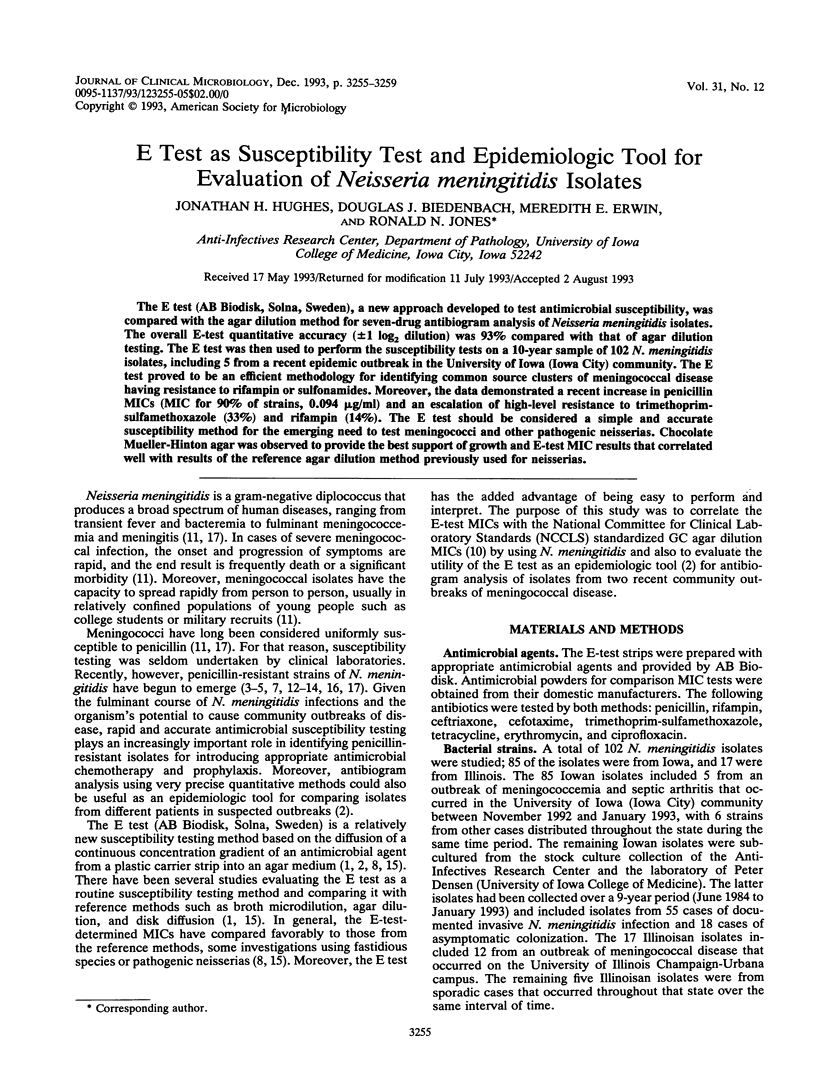
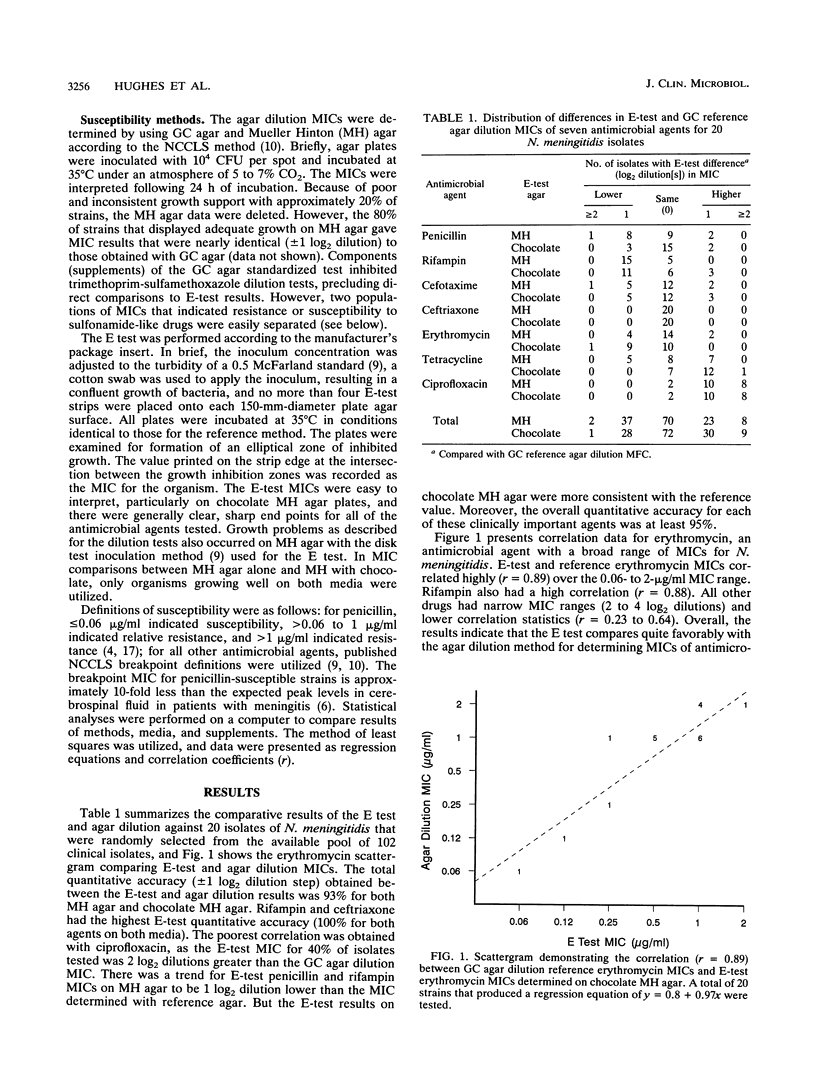
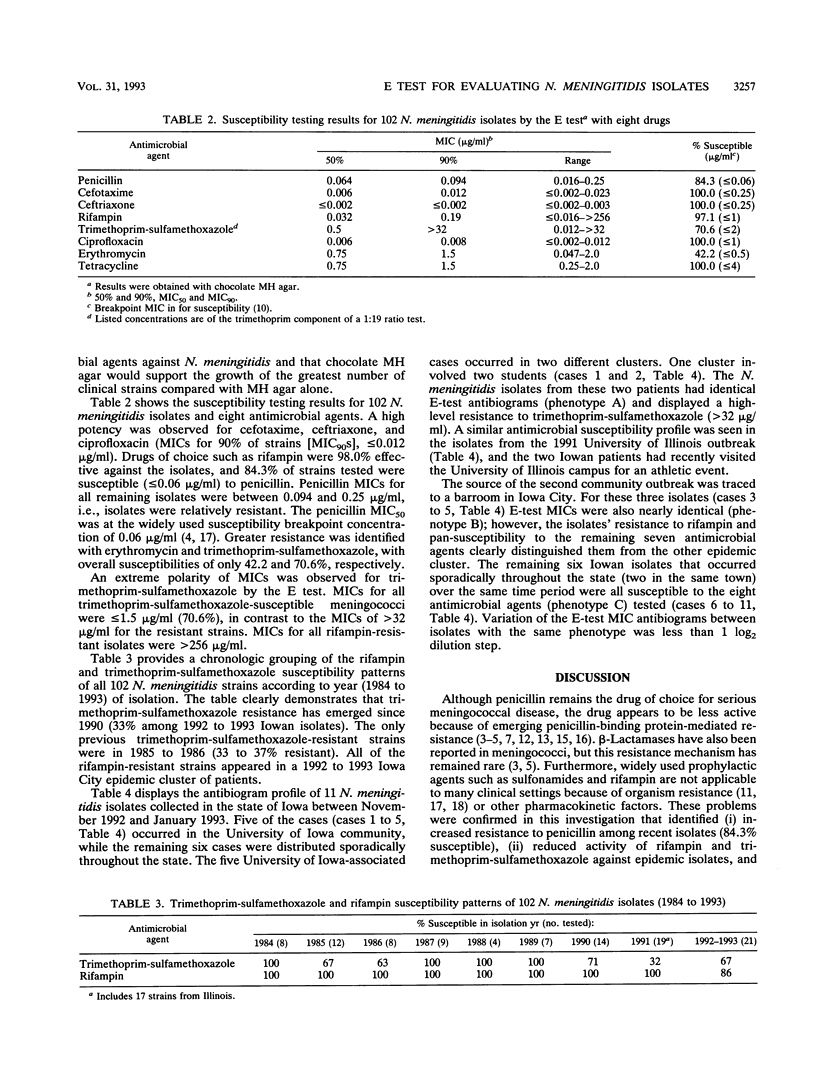
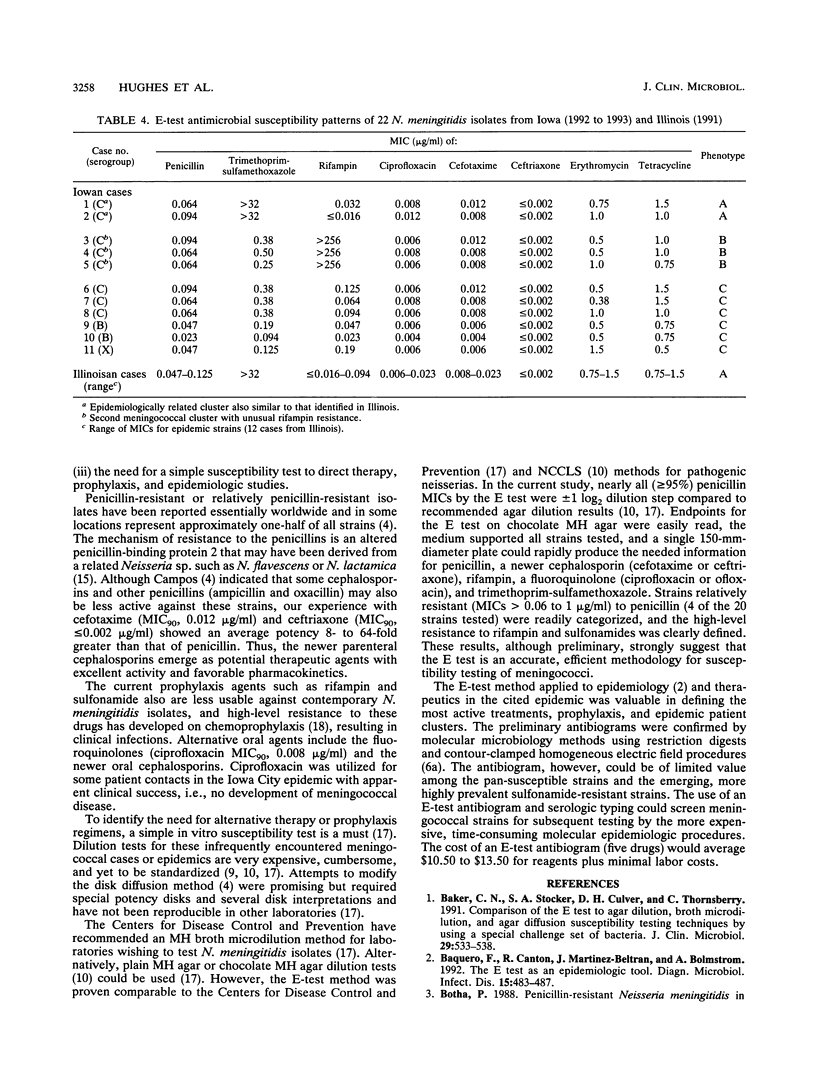
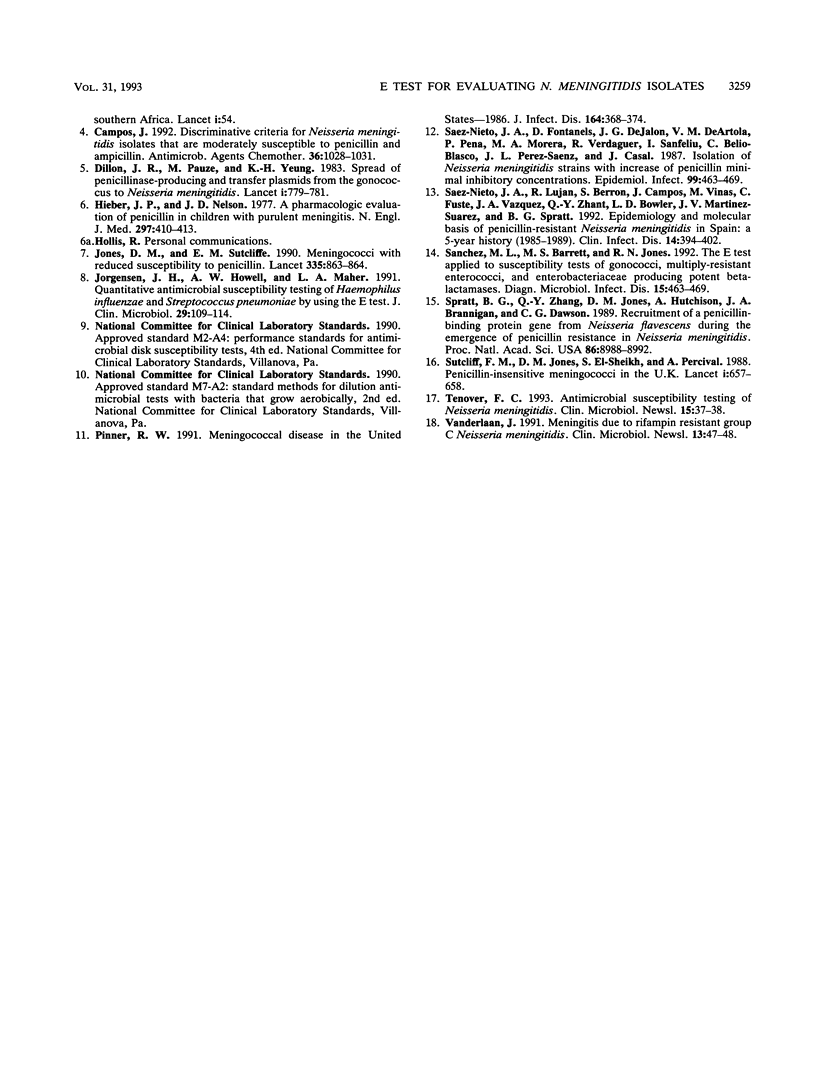
Selected References
These references are in PubMed. This may not be the complete list of references from this article.
- Baker C. N., Stocker S. A., Culver D. H., Thornsberry C. Comparison of the E Test to agar dilution, broth microdilution, and agar diffusion susceptibility testing techniques by using a special challenge set of bacteria. J Clin Microbiol. 1991 Mar;29(3):533–538. doi: 10.1128/jcm.29.3.533-538.1991. [DOI] [PMC free article] [PubMed] [Google Scholar]
- Baquero F., Cantón R., Martinez-Beltrán J., Bolmström A. The E-Test as an epidemiologic tool. Diagn Microbiol Infect Dis. 1992 Jul;15(5):483–487. doi: 10.1016/0732-8893(92)90095-b. [DOI] [PubMed] [Google Scholar]
- Botha P. Penicillin-resistant Neisseria meningitidis in southern Africa. Lancet. 1988 Jan 2;1(8575-6):54–54. doi: 10.1016/s0140-6736(88)91029-x. [DOI] [PubMed] [Google Scholar]
- Campos J., Trujillo G., Seuba T., Rodriguez A. Discriminative criteria for Neisseria meningitidis isolates that are moderately susceptible to penicillin and ampicillin. Antimicrob Agents Chemother. 1992 May;36(5):1028–1031. doi: 10.1128/aac.36.5.1028. [DOI] [PMC free article] [PubMed] [Google Scholar]
- Dillon J. R., Pauzé M., Yeung K. H. Spread of penicillinase-producing and transfer plasmids from the gonococcus to Neisseria meningitidis. Lancet. 1983 Apr 9;1(8328):779–781. doi: 10.1016/s0140-6736(83)91846-9. [DOI] [PubMed] [Google Scholar]
- Hieber J. P., Nelson J. D. A pharmacologic evaluation of penicillin in children with purulent meningitis. N Engl J Med. 1977 Aug 25;297(8):410–413. doi: 10.1056/NEJM197708252970802. [DOI] [PubMed] [Google Scholar]
- Jones D. M., Sutcliffe E. M. Meningococci with reduced susceptibility to penicillin. Lancet. 1990 Apr 7;335(8693):863–864. doi: 10.1016/0140-6736(90)90985-e. [DOI] [PubMed] [Google Scholar]
- Jorgensen J. H., Howell A. W., Maher L. A. Quantitative antimicrobial susceptibility testing of Haemophilus influenzae and Streptococcus pneumoniae by using the E-test. J Clin Microbiol. 1991 Jan;29(1):109–114. doi: 10.1128/jcm.29.1.109-114.1991. [DOI] [PMC free article] [PubMed] [Google Scholar]
- Pinner R. W., Gellin B. G., Bibb W. F., Baker C. N., Weaver R., Hunter S. B., Waterman S. H., Mocca L. F., Frasch C. E., Broome C. V. Meningococcal disease in the United States--1986. Meningococcal Disease Study Group. J Infect Dis. 1991 Aug;164(2):368–374. doi: 10.1093/infdis/164.2.368. [DOI] [PubMed] [Google Scholar]
- Sanchez M. L., Barrett M. S., Jones R. N. The E-Test applied to susceptibility tests of gonococci, multiply-resistant enterococci, and Enterobacteriaceae producing potent beta-lactamases. Diagn Microbiol Infect Dis. 1992 Jul;15(5):459–463. doi: 10.1016/0732-8893(92)90090-g. [DOI] [PubMed] [Google Scholar]
- Spratt B. G., Zhang Q. Y., Jones D. M., Hutchison A., Brannigan J. A., Dowson C. G. Recruitment of a penicillin-binding protein gene from Neisseria flavescens during the emergence of penicillin resistance in Neisseria meningitidis. Proc Natl Acad Sci U S A. 1989 Nov;86(22):8988–8992. doi: 10.1073/pnas.86.22.8988. [DOI] [PMC free article] [PubMed] [Google Scholar]
- Sutcliffe E. M., Jones D. M., el-Sheikh S., Percival A. Penicillin-insensitive meningococci in the UK. Lancet. 1988 Mar 19;1(8586):657–658. doi: 10.1016/s0140-6736(88)91469-9. [DOI] [PubMed] [Google Scholar]
- Sáez-Nieto J. A., Fontanals D., Garcia de Jalon J., Martinez de Artola V., Peña P., Morera M. A., Verdaguer R., Sanfeliu I., Belio-Blasco C., Perez-Saenz J. L. Isolation of Neisseria meningitidis strains with increase of penicillin minimal inhibitory concentrations. Epidemiol Infect. 1987 Oct;99(2):463–469. doi: 10.1017/s0950268800067960. [DOI] [PMC free article] [PubMed] [Google Scholar]
- Sáez-Nieto J. A., Lujan R., Berrón S., Campos J., Viñas M., Fusté C., Vazquez J. A., Zhang Q. Y., Bowler L. D., Martinez-Suarez J. V. Epidemiology and molecular basis of penicillin-resistant Neisseria meningitidis in Spain: a 5-year history (1985-1989). Clin Infect Dis. 1992 Feb;14(2):394–402. doi: 10.1093/clinids/14.2.394. [DOI] [PubMed] [Google Scholar]


